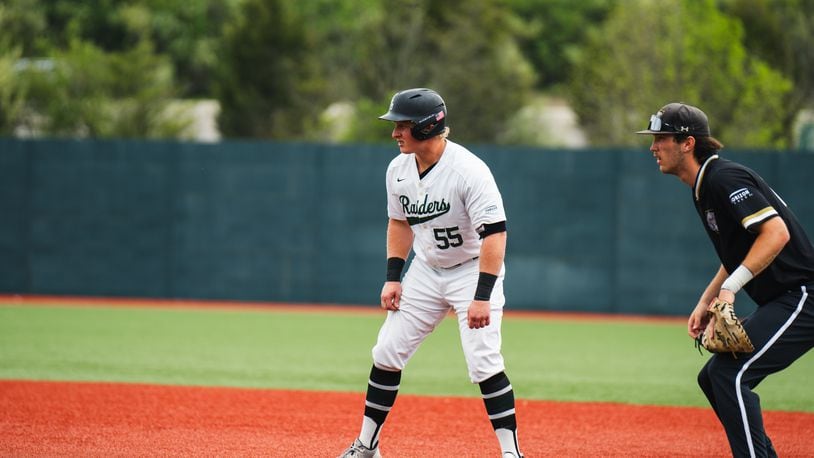“It’s a little boring out there,” he said, smiling. “When you’re catching, you’re in every play. I love being the leader of the defense, the only one facing that way (toward the field). I take pride in that.”
But while catchers normally get a pass as batters because of the demands of the job, the Upper Arlington product has defied that no-hit stereotype and has become a tough out.
A first-team All-Horizon League pick last year, he’ll take a .407 average into a three-game series at Oakland this weekend. And he’s not the only Raider with a legitimate crack at a .400 season.
Designated hitter Julian Greenwell, an all-league pick from Columbus East, leads the HL with a .415 average.
Both have hit for power this spring — Sass became the first player in league history to bash four homers in a game in a 22-21 loss to Miami, and Greenwell had two grand slams in a 16-11 win over Northern Kentucky — but batting .400 for a season would put them in rare territory.
Peyton Burdick was the last of six players in Wright State history to do it, hitting .407 in 2019.
Chris Tuttle set the school record with a .478 averge in 2001. And Jon Sbrocco is the only player to top ,400 twice, hitting .447 in 1991 and .409 in ‘92.
But one of the keys to being part of that exclusive club, it seems, is to avoid giving it any thought.
“I don’t really look at numbers. I just try to do what the team needs me to do,” Sass said.
“If there’s nobody on and nobody out, I’m just trying to find the barrel (of the bat). And if there’s people on, my job is to get them in.”
The Raiders are 25-17 and have just 11 more regular-season games before playing in the HL tourney.
“It’s always nice to know you’re doing well, but, ultimately, as a leadoff hitter, my mindset is just getting on base any way I can,” Greenwell said.
“It’s not so much the average, but on-base percentage, drawing walks, getting hit by a pitch, seeing the pitchers’ (tendencies) and relaying that to my teammates. That’s my main focus.”
Greenwell, one of four fifth-year players for the Raiders, batted .283 and .314 in his pervious two seasons as a starter. Asked what he’s doing differently, he said:
“I feel like this year I’m a lot more relaxed. It’s my last year, and going into this year, I told myself I was just going to have fun.
“For me, there’s not really a whole lot of pressure. It’s just enjoying the game I’ve played since I was a kid.”
Sass, who has started four of his five years and hit .362 in 2021, follows Greenwell in the batting order, and having them at the top of the lineup has helped the Raiders put up gaudy numbers offensively.
They began the week eighth in the country in runs, averaging 9.6 per game, and seventh in average at .324.
They also set a program record for consecutive double-digit scoring games with six.
“They’ve been so good for us at the top,” coach Alex Sogard said. “They’re extremely competitive. They both have played in three (NCAA) regionals, and they know what it takes to win games and to play in big games.
“They make us go offensively.”
Sometimes defensively, too.
Sass started Sunday’s game against Purdue Fort Wayne in left field but finished at catcher. And he helped to preserve the 2-1 win with a dazzling play in the ninth, snagging a pop foul on a failed bunt attempt with a runner on and nobody out.
He couldn’t locate the ball at first, but then went into a full sprint and caught it while sliding into the backstop.
“The coaches and our bench were yelling where it was. I found it and ran it down,” he said, before adding sheepishly:
“I’m sure playing in the outfield earlier in the game, tracking down some balls, helped me behind the plate.”
About the Author
